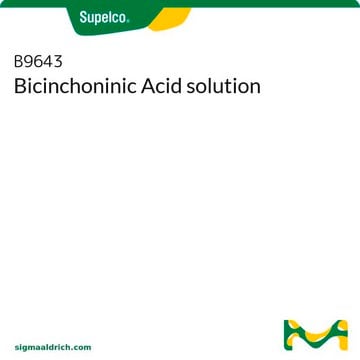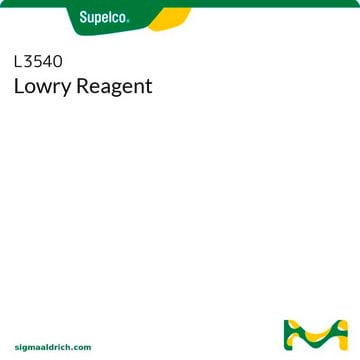QPBCA
QuantiPro™ BCA Assay Kit
for 0.5-30 μg/ml protein
Synonym(s):
BCA Assay, Protein determination by BCA, bicinchoninic acid reagent
Sign Into View Organizational & Contract Pricing
All Photos(1)
About This Item
UNSPSC Code:
12161503
NACRES:
NA.84
Recommended Products
shipped in
wet ice
storage temp.
2-8°C
Application
In addition to protein determination and quantification in solution, the QuantiPro™ BCA Assay Kit has other applications, including determination of protein covalently bound to agarose supports and protein adsorbed to multiwell plates. It has also been applied to the determination of functional groups such as sulfhydryl, N-hydroxysuccinimido carboxylate, aldehyde and hydrazide on a variety of solid supports.
The kit can be used to measure very dilute protein concentrations in very small sample volumes. Accurately measures protein concentrations from 0.5 to 30 μg/mL in tube assays and 1 to 20 μg/mL in 96- or 384-well plate assays.
Features and Benefits
- Accurate across a broad range of protein concentrations
- High sensitivity; linear response form 0.5 to 30 μg/ml of protein
- Stable color complex
- Reduced susceptibility to detergents
Principle
Based on the alkaline reduction of Cu2+ to Cu1+ by proteins, and the formation of a bicinchoninic acid:Cu1+ complex having an absorbance maximum at 562 nm.
Storage and Stability
Store Reagents QA, QB, and QC at room temperature. Reagents QA and QB can be mixed together without Reagent QC (4% Copper(II) Sulfate Pentahydrate Solution 12 mL) and stored in a closed container at room temperature for a week. If this kit is received or stored cold, a precipitate may form in Reagent QA or Reagent QB. To dissolve the precipitate, warm the solution slowly to room temperature while mixing. The solutions are now suitable for use.
Legal Information
QuantiPro is a trademark of Sigma-Aldrich Co. LLC
Kit Components Only
Product No.
Description
- Copper(II) sulfate solution, 4 % (w/v) (prepared from copper (II) sulfate pentahydrate) 12 mL
Kit Components Also Available Separately
Product No.
Description
SDS
- P0914Protein Standard Solution: 1.0 mg/ml bovine serum albumin in 0.15 M NaCl with 0.05% sodium azide (flame-sealed glass ampules) 10 x 1SDS
Application
Product No.
Description
Pricing
related product
Product No.
Description
Pricing
Signal Word
Danger
Hazard Statements
Precautionary Statements
Hazard Classifications
Aquatic Acute 1 - Aquatic Chronic 1 - Eye Dam. 1 - Met. Corr. 1 - Skin Irrit. 2
Storage Class Code
8A - Combustible corrosive hazardous materials
Certificates of Analysis (COA)
Search for Certificates of Analysis (COA) by entering the products Lot/Batch Number. Lot and Batch Numbers can be found on a product’s label following the words ‘Lot’ or ‘Batch’.
Already Own This Product?
Find documentation for the products that you have recently purchased in the Document Library.
Customers Also Viewed
Sook Hyun Chung et al.
Scientific reports, 6, 28993-28993 (2016-07-05)
Vascular changes and photoreceptor degeneration are features of age-related macular degeneration, diabetic retinopathy and macular telangiectasis. We have profiled the differential expression of microRNAs and analysed their target genes in transgenic mice in which induced Müller cell disruption results in
Eneida V Reis et al.
Parasitology international, 63(1), 120-126 (2013-10-24)
Vaults are ribonucleoproteins (13 MDa) highly conserved among lower and higher eukaryotes. Their association produces a complex composed of three proteins named Major Vault Protein (MVP), vault (PolyADP-ribose) polymerase (VPARP) and Telomerase-associated protein (TEP1), plus a small untranslated RNA. The
Comparison of the glycopattern alterations of mitochondrial proteins in cerebral cortex between rat Alzheimer?s disease and the cerebral ischemia model
Yu H,et al.
Scientific reports (2017)
PPAR-? agonist GL516 reduces oxidative stress and apoptosis occurrence in a rat astrocyte cell line
Neurochemistry International (2019)
Jingwei Zhang et al.
Acta biomaterialia, 10(7), 3254-3263 (2014-04-01)
The microporosity of calcium phosphate (CaP) ceramics has been shown to have an essential role in osteoinduction by CaP ceramics after ectopic implantation. Here we show that it is not the microporosity but the size of surface microstructural features that
Our team of scientists has experience in all areas of research including Life Science, Material Science, Chemical Synthesis, Chromatography, Analytical and many others.
Contact Technical Service











